To continue the previous edition in the title “Birds of Solomon Islands 2005 (Part 3)- Parrots”, detail of the depicted parrot species such as: Finsch’s pygmy parrot (Micropsitta finschii), Cardinal Lory (Chalcopsitta cardinalis), Solomons Cockatoo (Cacatua ducorpsii), Eclectus Parrot (Eclectus roratus), Rainbow Lorikeet, (Trichoglossus haematodus), Song Parrot (Geoffroyus heteroclitus) have described in the following paragraphs.
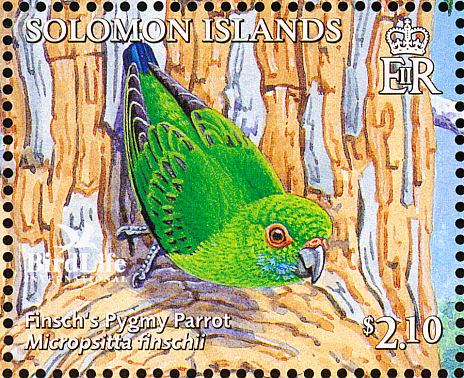 Finsch’s Pygmy Parrot (Micropsitta finschii)
Finsch’s Pygmy Parrot (Micropsitta finschii)
Finsch’s pygmy parrot (Micropsitta finschii), also known as the green or emerald pygmy parrot, is characterized by a green head and neck (which is unique among species of the genus Micropsitta). The typical length of a green pygmy parrot is 9.5 cm with an average weight of 12 g . Male and female individuals can be identified by slight differences in coloration
Finsch’s pygmy parrots are found in tropical rainforests up to an elevation of 900 m.The geographic range of this species includes Papua New Guinea, Solomon Islands, and the Bismarck Archipelago.
Finsch’s pygmy parrots are often found in pairs or small groups (3-6 individuals). The groups often include socially monogamous (for up to a year) mating pairs. The breeding season is from March to May and a typical clutch produced will have 1 or 2 eggs. The parrot feeds on fungi and lichens found on the tree bark, as well as the seeds of the Casuarina tree in which it is commonly found.
Micropsitta finschii have specific ranges of each subspecies are as follows:
- M f. finschii is found in the southern Solomon Islands,
- M f. aolae is found in the central Solomon Islands,
- M f. tristami is found in the western Solomon Islands,
- M f. nanina is found in the northern Solomon Islands and eastern Papua New Guinea,
- M f. viridifrons is found in eastern Papua New Guinea and the Bismarck Archipelago.
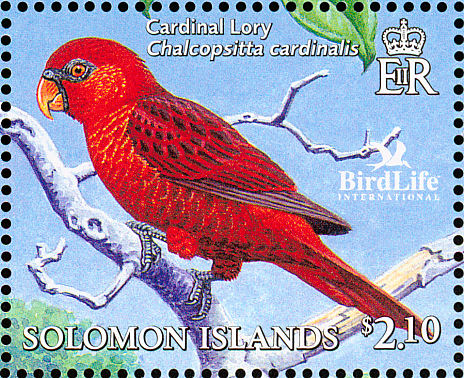
Cardinal Lory (Chalcopsitta cardinalis)
The Cardinal Lory (Chalcopsitta cardinalis) is a monotypic species of parrot in the Psittaculidae family. The Cardinal Lory lives mainly in the mangrove and the lowland forests of the Solomon Islands and east Papua New Guinea.
The Cardinal Lory is 31 cm long. All plumage is red. The beak is orange with black at its base. The bare skin at base of beak and around eyes is black, and the irises are orange-red. Its legs are grey. The male and female are identical in external appearance. The beaks of the juveniles are dull orange with more prominent black areas than the adults, pale grey eye-rings, and yellow irises.
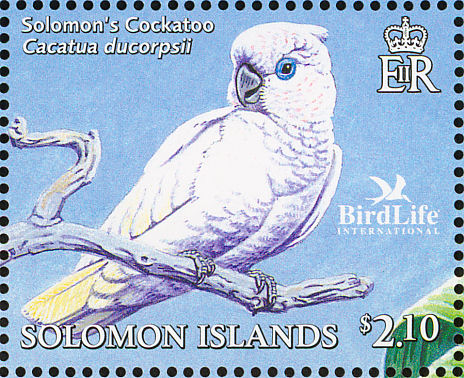
Broad-crested Corella ( Cacatua ducorpsii )
The Solomons Cockatoo (Cacatua ducorpsii), is a species of cockatoo endemic to the Solomon Islands. This small white cockatoo is larger than the Tanimbar Corella but smaller than the Umbrella Cockatoo. It inhabits lowland rainforests, secondary forests, cleared areas and gardens.
The Solomons Cockatoo is about 30 cm long. They are predominantly white. They have a blue eye ring and a recumbent crest which resembles a sail in its raised state.
The Solomons Cockatoo nests in tree cavities. The eggs are white and there are usually two in a clutch. The eggs are incubated for about 25 days and the chicks leave the nest about 62 days after hatching.
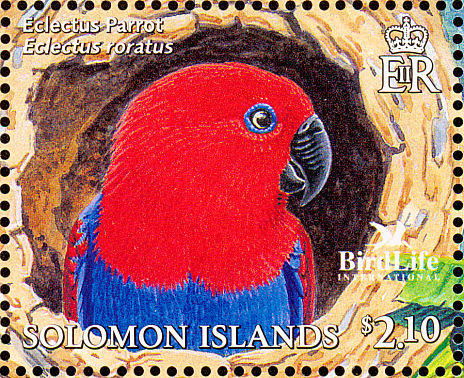
Eclectus Parrot ( Eclectus roratus )
The Eclectus Parrot (Eclectus roratus) is a parrot native to the Solomon Islands, Sumba, New Guinea and nearby islands, northeastern Australia and the Maluku Islands (Moluccas).
It is unusual in the parrot family for its extreme sexual dimorphism of the colours of the plumage; the male having a mostly bright emerald green plumage and the female a mostly bright red and purple/blue plumage. Their bright feathers are also used by native tribes people in New Guinea as decorations.
In its natural habitat, the Eclectus Parrot nests within hollows in large, emergent rainforest trees. Males may travel up to 20 km to forage and up to five males will regularly provide food for each female, each competing with the others for her affections and the right to father her young.
Eclectus parrots are polygynandrous—females may mate with multiple male suitors and males may travel from nesting site to nesting site to mate with multiple females.
The male is primarily a green color, likely for the purpose of camouflage amongst the trees whilst foraging. However, the plumage of both sexes appears spectacular when viewed in the ultraviolet spectrum, an ability which predators such as hawks and owls lack
The diet of the eclectus parrots in the wild consists of mainly fruits, wild figs, unripe nuts, flower and leaf buds, and some seeds. Two favorite fruits are the pomegranate and the papaya (pawpaw) with seeds.
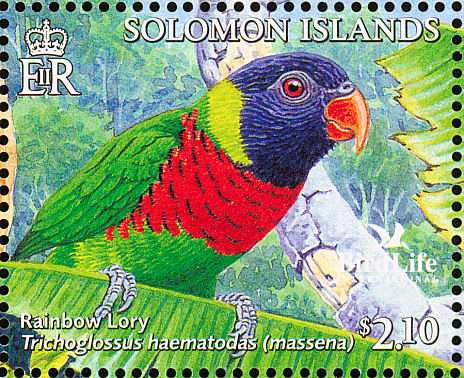
Rainbow Lorikeet (Trichoglossus haematodus)
The Rainbow Lorikeet, (Trichoglossus haematodus) is a species of Australasian parrot found in Australia, eastern Indonesia (Maluku and Western New Guinea), Papua New Guinea, New Caledonia, Solomon Islands and Vanuatu. Its habitat is rainforest, coastal bush and woodland areas.
Rainbow Lorikeets often travel together in pairs and occasionally respond to calls to fly as a flock, then disperse again into pairs. Rainbow Lorikeet pairs defend their feeding and nesting areas aggressively against other Rainbow Lorikeets and other bird species.
Rainbow Lorikeets feed mainly on fruit, pollen and nectar, and possess a tongue adapted especially for their particular diet. The end of the tongue is equipped with a papillate appendage adapted to collecting nectar from flowers.
Overall, the Rainbow Lorikeet remains widespread and often common. It is therefore considered to be of Least Concern by BirdLife International. Its being threatened by habitat loss and capture for the parrot trade .
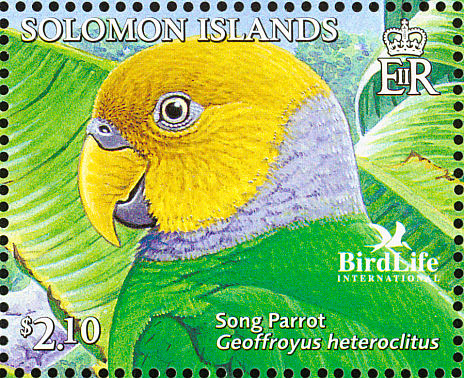
Song Parrot (Geoffroyus heteroclitus)
The Song Parrot (Geoffroyus heteroclitus) is a species of parrot in the Psittaculidae family. It is found in Papua New Guinea and Solomon Islands. Its natural habitat is subtropical or tropical moist lowland forests.
The colours of Adult male Song Parrot :
- Generally the male is green in colour with yellow head; collar around neck grey/lilac;
- The under-wing coverts are blue with yellow upper mandible, grey lower mandible.
- The eye ring is grey with the eye’s yellow colour.
Meanwhile the adult female Song Parrot has grey head without blue collar and the bill is grey. The Juvenile’s color same as in adult female but crown washed with green. The bill’s color is pale grey with dull yellow at base. The cere flesh is pink instead of grey. The eye ring white with the grey eye.
Calls are described as raucous and loud, both perched and in flight; also emits high-pitched whistling song consisting of two notes.

You have shared very good information. And this is very valuable. People get more benefits from reading about such information. Thank you so much for this
ReplyDeleteTemico Stamps
Thank you so much for this wonderful information .This is really important for me .I am searching this kind of information from a long time and finally got it.
ReplyDeletebhiwani postal code
Do this hack to drop 2lb of fat in 8 hours
ReplyDeleteMore than 160 000 men and women are trying a simple and SECRET "liquid hack" to burn 2lbs each night as they sleep.
It is easy and works on everybody.
Here are the easy steps for this hack:
1) Get a glass and fill it up half glass
2) Now do this weight losing HACK
you'll be 2lbs thinner in the morning!
Your blog is very good. It has very good information.
ReplyDeletewww.dreampost.in
ok
ReplyDeleteAvian parrot for sale is a simple and well-known online aviary store with healthy parrots available for rehoming. You will find parrots like African grey and macaw birds.
ReplyDelete